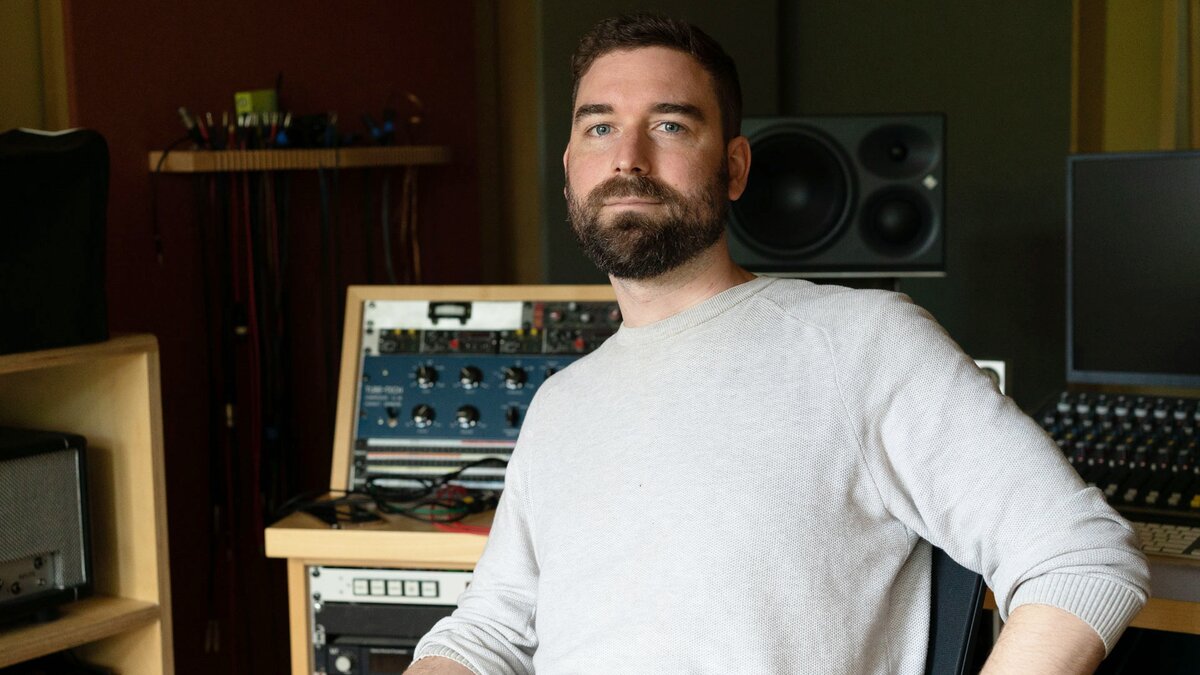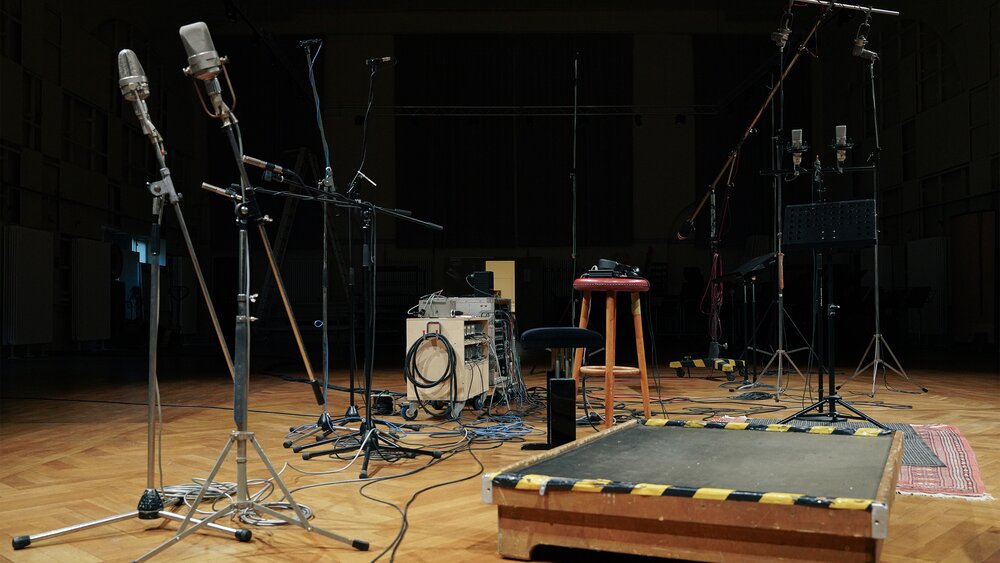
When it comes to orchestral music, there aren't many locations in the world that can compete with Teldex Studio in Berlin. It's the largest independent recording facility in Germany, with a 455-square-meter live room that has almost the same size and proportions as Abbey Road's Studio One, and boasts ideal acoustics for orchestral recordings. As well as this, the studio potentially has the biggest collection of vintage Neumann microphones in the world. In other words—it's the perfect space for recording orchestral tools collections.
The relationship between Orchestral Tools and Teldex began in 2012, when the first installation of the Berlin Series—Berlin Woodwinds—was recorded there. Since then, Teldex Studio has become the sonic home for Orchestral Tools, allowing us to reach new levels of orchestral sampling and deliver rich, detailed, and flexible instrument collections that will add new layers to your symphonic compositions. The pinnacle of all this is the Berlin Series, our flagship collection. In the second part of our interview with CEO and co-founder of Orchestral Tools Hendrik Schwarzer, we discuss how crucial Teldex was in the recording of the series.
How did the idea to record the Berlin Series at Teldex come about?
Originally, there wasn't much of a plan to record the Berlin Series—the initial idea was just to create a woodwind library. We had actually booked somewhere completely different, but somehow the room got changed and we decided we needed a new place to record in. I remembered Teldex from the presets on the Altiverb convolution reverb plugin, so I thought I should give them a call. We initially booked the studio for a little over two weeks, just to get the woodwinds recorded there.
The woodwinds sounded so amazing at Teldex that I later decided to record a custom brass library there, just for myself, because there were some dynamics and articulations that I felt were missing in all the other commercial brass libraries. I ended up doing night sessions with a friend of mine, Sasha Knorr, who now does a lot of demo composing for Orchestral Tools, and Tom Russbueldt, who was an engineer at Teldex at the time. Little by little, we found ourselves recording more and more instruments at Teldex, before we eventually decided to move forward with Berlin Strings—the next library in the Berlin Series.
What makes Teldex such a perfect space for orchestral sampling?
Through the course of those early recordings I discovered how well the room at Teldex works for orchestral sampling. Normally the rooms are too small, which means you hear reflections from the walls, especially when the brass is playing. Also, you get certain frequencies that really resonate in the space, but in a negative way. This is a big issue when it comes to sampling, because sometimes you'll have more than 1,000 voices playing in the sample player at the same time, and when that happens this resonance becomes very noticeable. In contrast, Teldex is quite flat, but you get a sort of air shimmering effect on top of everything that's like ear candy.
The real benefit of recording at Teldex though is that it's not a very dry space. In dry environments you hear the walls of the room, but you also struggled to get a cohesive sound with all the instruments, especially if you're then adding artificial reverbs on top. On the other hand, if you record in a huge concert hall with a very long natural reverb tail you get a really nice blend of instruments, but you're never able to get rid of the reverb! The ultimate goal is to have a balance so that you have flexibility when it comes to your orchestrations, and that's what Teldex offers.
Besides the live room, what makes Teldex unique?
They also have this amazing collection of microphones; M50s, U47s—all the Neumann microphones that everyone goes crazy over. These are all incredibly sought after vintage mics, but they bought them back in the day when they originally came out—they were just mics then! Nowadays they still keep all of this great equipment up to date, making sure everything is repaired carefully. If something does break they have connections with experts and also with Neumann themselves, who are also based in Berlin. Neumann tested out a lot of their microphones at Teldex, so there's a very close relationship between the two.
Teldex is a place with a really rich history. Originally it acted as a kind of emergency room when orchestras weren't able to go into concert halls like the Berlin Philharmonic. Later on, orchestras would use the space to record in, until Teldec (who were the original record label who owned the studio) sold everything and closed down all the recording studios. However, the engineers who worked there decided to keep the place. They put a lot of investment into it themselves, and have tons of Grammys for all the different classical and film music recordings that have been made there. It's just a perfect place for any kind of acoustic recording, and especially for sampling. I've done a lot of other orchestral recordings in other places across Europe, and Teldex is the one that stands out from the rest. The Teldex name is a mark of quality.

The Berlin Series gives users a wide selection of different microphone positions—why was it important to offer that feature?
When you record an orchestra for a soundtrack recording, you obviously have the main mics. As well as that you have support mics for the flute, the French horns, maybe the entire woodwind section, and so on. At the end, when you do the mixing, you have all these microphone perspectives and you have to make decisions. The basic setup is that you have your decca tree mics, the surround mics that you'll hear at the back of the cinema, and some reverb to capture the room. The composition might feature the flute in a solo passage however, so you then diall in the close mics to let that little moment with the melody shine. Then maybe in another part of the piece you need to really focus on the solo cello, so you do the same again.
This is one approach to recording an orchestra, and you can do this with the Berlin Series. Another option is to have the orchestra sound a bit more dry and more direct. A good example is the Star Wars soundtrack recordings at Abbey Road. Abbey Road is comparable to Teldex when it comes to its reverberance, because the size and layout of the rooms are very similar. The early Star Wars soundtracks sound very direct, because that was the kind of aesthetic they were looking for at the time. This is something that you can also achieve with the Berlin Series, by having a good balance between the main mics and keeping all the close mics on at the same time, adjusting them depending on how direct you would like the sound.
What are some of the lessons that you’ve learned about sampling from your experience recording the Berlin Series?
I often say that sampling is a very similar job to photography. A photographer has all these decisions to make regarding the light, location, object, and time of day. It's only once the shot is perfectly set up that they can take the picture, and then after that there might be some editing and processing involved. Sampling is a very similar thing; because we rely on recordings that we capture in a certain moment that can't ever be re-created. If you record a Baroque violin, it will never turn into a French violin afterwards. Of course, you could add a lot of processing in there to affect the sound in some way, but ultimately it would still be a Baroque violin and not a French violin. For this reason I think when you're sampling you have to be very clear from the beginning on what you want the library to do.
All four of the main Berlin Series collections are available in a cost-saving bundle , or you can purchase them individually from our product page. You can learn more about Teldex Studio's legendary history and go behind the scenes with Peter Kirn on a tour of the studio.